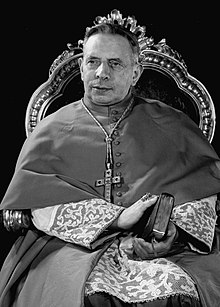Giacomo Lercaro
This article includes a list of generalreferences,butit lacks sufficient correspondinginline citations.(January 2013) |
Giacomo Lercaro | |
|---|---|
| Cardinal,Archbishop of Bologna | |
 Photograph byDmitri Kessel,1954 | |
| Church | Catholic Church |
| Archdiocese | Bologna |
| Appointed | 19 April 1952 |
| Installed | 22 June 1952 |
| Term ended | 12 February 1968 |
| Predecessor | Giovanni Battista Nasalli Rocca di Corneliano |
| Successor | Antonio Poma |
| Other post(s) | Cardinal-Priest of Santa Maria in Traspontina(1953–76) |
| Orders | |
| Ordination | 25 July 1914 by Ildefonso Vincenzo Pisani |
| Consecration | 19 March 1947 byGiuseppe Siri |
| Created cardinal | 12 January 1953 byPius XII |
| Rank | Cardinal-Priest |
| Personal details | |
| Born | Giacomo Lercaro 28 October 1891 Quinto al Mare,Genoa,Kingdom of Italy |
| Died | 18 October 1976(aged 84) San Lazzaro di Savena,Bologna,Italy |
| Previous post(s) |
|
| Alma mater | Pontifical Biblical Institute |
| Motto | Mater mea fiducia mea |
| Coat of arms |  |
| Styles of Giacomo Lercaro | |
|---|---|
 | |
| Reference style | His Eminence |
| Spoken style | Your Eminence |
| Informal style | Cardinal |
| See | Bologna |
Giacomo Lercaro(28 October 1891 – 18 October 1976) was anItaliancardinalof theRoman Catholic Churchwho served asArchbishop of Ravennafrom 1947 to 1952, andArchbishop of Bolognafrom 1952 to 1968.Pope Pius XIImade him a cardinal in 1953.
Biography
[edit]
Early life and ordination
[edit]Giacomo Lercaro was born in Quinto al Mare,Genoa,as the eighth of nine children. He came from a family of seamen, and two of his brothers, Amedeo and Attilio, also entered religion. From 1902 to 1914, Lercaro attended the archdiocesanseminaryin Genoa. He wasordainedaprieston 25 July 1914 by Archbishop Ildefonso Pisani, and four months later, in November, travelled to Rome to study at thePontifical Biblical Institute.
Pastoral and theological work
[edit]When Italy enteredWorld War I,Lercaro was forced to change posts and become a militarychaplainuntil the war ended in 1918. In 1918, he became prefect of the Seminary of Genoa, where his brother Amedeo wasrector,and would remain in that post until 1923. He also served assubstitute professoroftheology(1921–1923) andprofessorofsacred scriptureandpatrology(1923–1927). In 1927 he became a teacher of religion insecondary schooland became involved in numerous student movements in the Genoa district.
Archbishop
[edit]He received hisepiscopal consecrationon 19 March 1947 from ArchbishopGiuseppe Siri,with Archbishop Angleo Rossini and Bishop Francesco Canessa serving asco-consecrators.In theconsistoryof 12 January 1953, Lercaro was createdCardinal-PriestofSanta Maria in Traspontinaby Pius XII.
Cardinal
[edit]During his early years as a cardinal, Lercaro established his first contacts withAngelo Roncalliand became well known for the way in which he turned his episcopal palace into anorphanage.Although he had been seen by Vatican watchers ever since 1953 as a possible successor to Pius XII and was listed byl'Osservatore Romanoas apapabile,his reputation as the most idiosyncratic of all the cardinals and the desire for a transitional pontiff saw him passed over in favor of Roncalli in1958.
A friend of theFreemasonandpiduistUmberto Ortolani,who had grown up economically and politically inBologna,he was one of the first members of the Catholic hierarchy to establish a dialogue with theCommunists.[1]Generally consideredpapabilein the1963 papal conclaveclosest to the vision of John XXIII, Lercaro, however, was considered tooliberalby most of his fellowcardinal electorsto be elected;Giovanni Battista Montiniultimately won.
Although Cardinal Lercaro did much vital work in implementing theSecond Vatican Councilafter it closed in 1965, his advancing age saw him gradually disappear from prominence within the Church as the 1960s drew to a close. On 12 February 1968, Cardinal Lercaro was forced to step down from his position as Archbishop of Bologna and in 1971, he lost his right to participate in any future conclave upon reaching the age of eighty according to the then-recentmotu proprioIngravescentem aetatem.
Death
[edit]Lercaro died from a cardiac crisis in Bologna, ten days short of his 85th birthday. He was buried in the metropolitan cathedral of that city.
Views
[edit]Anti-fascism
[edit]His involvement in these student movements gave Lercaro a great interest in engaging Catholic theology with modern culture, and during the war he became one of the most prominentanti-fascistswithin the Church, preaching steadfastly againstNazismand offering support in his home for those persecuted byMussolini—most notably forItalian Jewswhose persecution began as a result of Italy's collaboration withNazi Germany.At one point duringWorld War II,Lercaro was forced to operate under the alias of "Father Lorenzo Gusmini" and live in a vacant monastery cell to avoid being killed by Nazi collaborators.
Anti-communism
[edit]Lercaro's reputation as an outspoken critic of communism is believed to be a contributing factor inPope Pius XII's decision to make him the firstArchbishop of Ravenna(31 January 1947) and then the twentiethArchbishop of Bologna(19 April 1952), both considered among the largest Italian cities under communist rule.
Second Vatican Council
[edit]Even though Lercaro felt that Pope John was moving much too quickly when he first announced theSecond Vatican Councilin late 1959, he later sat on its board of presidency and became regarded as one of the main architects of the council'sliturgicalreforms.
Church of the poor
[edit]Cardinal Lercaro was also the first to popularize the theory of a "Church of the poor" that developed further in Latin America during the 1970s. During his tenure as archbishop ofBologna,where the most popular political party was theItalian Communist Party,he tried to build a dialogue with the members of this party.
See also
[edit]References
[edit]External links
[edit]- Cardinals of the Holy Roman Church biographyArchived17 August 2014 at theWayback Machine
- Catholic-Hierarchy profile
- "Religion: The Cardinal's Comeback".Time.30 March 1953.
- "Who Fired the Cardinal?".Time.13 December 1968.
- Cardinals created by Pope Pius XII
- 1891 births
- 1976 deaths
- Clergy from Genoa
- 20th-century Italian cardinals
- Participants in the Second Vatican Council
- Roman Catholic archbishops of Bologna
- 20th-century Italian Roman Catholic archbishops
- Italian military chaplains
- World War I chaplains
- Pontifical Biblical Institute alumni
